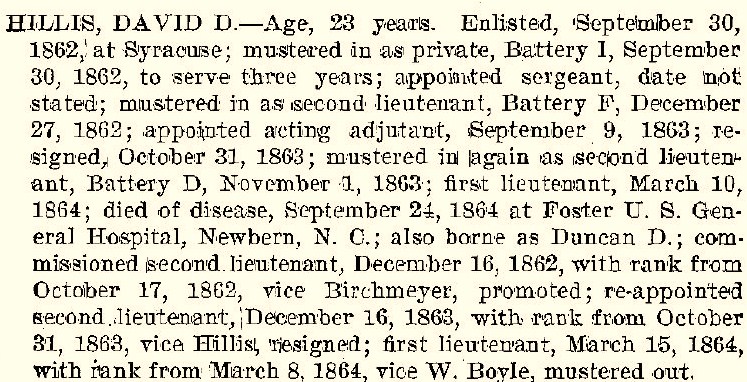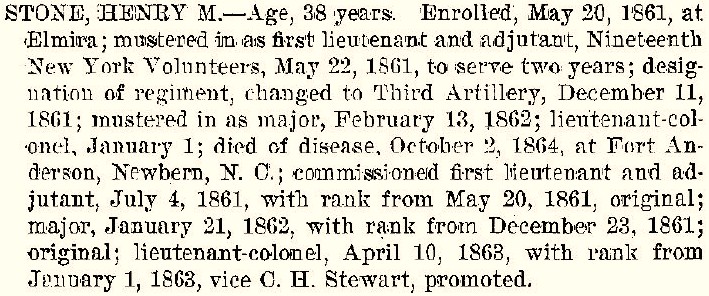From a Seneca County, New York newspaper in October 1864:
DEATH OF LIEUT. HILLIS. – Lieut. D.D. Hillis, of the 3d N.Y. Artillery, died at Newbern, N.C. a few days since, of Yellow Fever. Lieut. Hillis was very generally known in this vicinity, having been employed for several years here as a civil engineer on the Cayuga and Seneca Canal. He was a young man of much promise, and his many friends are deeply pained at his sudden death.
From a Seneca County, New York newspaper in October 1864:
Death of Lieut. Col. Stone.
We are pained to announce the death of LIEUT. COL. HENRY M. STONE, of the 3d. New York Artillery, which occurred a few days since at Newbern, N.C. Col. Stone was one of the first to volunteer on the breaking out of the rebellion, and went o[?] as Adjutant of the old 19th Regiment, raised in Cayuga, Seneca and Wayne counties.
Col. Stone was for many years connected with the press, and at the time he entered the service was publisher of the Auburn Daily Democrat. He was an active business man, a courteous and affable gentleman, and a brave and accomplished soldier. The news of his death will sadden many hearts and moisten many eyes.
Yellow Fever took a large toll on the regiment during the fall of 1864. From Cayuga in the Field[1]
The army in North Carolina, in the fall of 1864, was ravaged by an enemy more terrible by far to its gallant warriors, than any to be encountered on the field of battle. July 23d, Surgeon Wilson, of the 3d Artillery, announced to Col. Stewart the appearance in the regiment of a grave type of fever. In August the yellow fever stalked into Newbern. A commissary ship at the lower end of the city was first attacked by the grisly destroyer, and then the fever leaped ashore, followed up the line of the Neuse, then the line of the Trent, and soon extended into nearly every camp at the Post. Over 200 were attacked in the 3d Artillery alone. Col. Stewart, Maj. Kennedy, Lieut.-Col. Stone, and large numbers of the leading officers had it among the rest. Lieut. Hillis died of it September 24th. Lieut.-Col. Stone died of it October 2d. Also sixty men – thirty-seven of the number being in Battery D alone. They were buried in the regimental cemeteries. The regiment at one time alone had three hospitals. An immense panic prevailed in Newbern and hundreds of the residents left the city for safety. Stores were closed and business in every department of trade was abruptly brought to a stand. Drills were also arrested in the camps. The plague was most gallantly and faithfully fought by Surgeons of the Post and several of them lost their lives by exposing themselves to its attacks. During its prevalence great fires of tar and rosin were burnt in the camps and on the corners of the streets in the city, every night, to disinfect the air. The disease was at last got under control, and on October 9th, a heavy frost came to forbid its further spread. In order to secure the full benefit of this frost, Col. Stewart caused the stores of Newbern to be opened at night so that a draft of air might pass through them all. the owners of some obstinately refused to open them, when the thing was promptly done with an axe. A guard was set over each store to save it from depredation. Another frost two days after finished the plague. By October 29th, there was a general resumption of business.
The death of Lieut.-Col. Stone was deeply mourned in the regiment. He was a brave officer and a gentleman, and exceedingly popular with field, staff and line. He was uniformly kind and considerate of others and yet a disciplinarian . At the time of his death, he was in command of the forts and defenses north of the Neuse. …
Mosquito bites spread yellow fever; cold weather slows down mosquito activity.
- [1]Hall, Henry, and James Hall Cayuga in the Field. 1873. Aurora,New York: Talbothays Books. Print. page 201.↩


